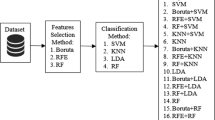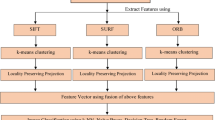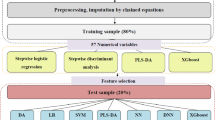Abstract
In this paper, a novel handwritten digit recognition system is proposed. The system consist of feature extraction, feature selection and classification stages. The features of digits are extracted by using the moment-based and structural-based methods. For the moment-based method, wavelet-based two-dimensional scaling moments (2-DSMs), which have uniquely different angular divisions of polar form, are considered. The structural-based features including profiles, intersections of horizontal and vertical straight lines, concavity, number and location of holes are used. In the feature selection stage, Fisher’s linear discriminant analysis is used to obtain the discriminative features. The feature selection is performed to improve not only the processing time but also recognition rates. In the classification stage, the digits are classified by neuro-fuzzy classifiers (NFCs). A three-stage cascade NFCs with rejection strategy is used in the system to improve the misclassification rate for the handwritten digit recognition task. The experiments are performed on the MNIST and USPS handwritten digit databases. The high correct classification rates of 98.72 % for MNIST and 97.21 % for USPS are attained by using only one hundred robust hybrid features and cascade NFCs. The experiments showed that the proposed system yields better results among those systems that use only moment-based features.






Similar content being viewed by others
References
Liu CL, Nakashima K, Sako H, Fujisawa H (2003) Handwritten digit recognition: benchmarking of state-of-the-art techniques. Pattern Recogn 36(10):2271–2285
Borji A, Hamidi M, Mahmoudi F (2008) Robust handwritten character recognition with features inspired by visual ventral stream. Neural Process Lett 28:97–111
Teow LN, Loe KF (2002) Robust vision-based features and classification schemes for off-line handwritten digit recognition. Pattern Recogn 35(11):2355–2364
Niu XX, Suen CY (2012) A novel hybrid CNN–SVM classifier for recognizing handwritten digits. Pattern Recogn 45(4):1318–1325
Zhang P, Bui TD, Suen CY (2007) A novel cascade ensemble classifier system with a high recognition performance on handwritten digits. Pattern Recogn 40:3415–3429
Nguyen MH, de la Torre F (2010) Optimal feature selection for support vector machines. Pattern Recogn 43(3):584–591
Zhang P, Bui TD, Suen CY (2005) Hybrid feature extraction and feature selection for improving recognition accuracy of handwritten numerals. In: Proceedings of the 2005 8th international conference on document analysis and recognition, vol 1, pp 136–140
Tan CC, Eswaran C (2010) Reconstruction and recognition of face and digit images using autoencoders. Neural Comput Appl 19(7):1069–1079
Goltsev A, Gritsenko V (2009) Modular neural networks with Hebbian learning rule. Neurocomputing 72(10–12):2477–2482
Lauer F, Suen CY, Bloch G (2007) A trainable feature extractor for handwritten digit recognition. Pattern Recogn 40(6):1816–1824
Heutte L, Paquet T, Moreau JV, Lecourtier Y, Olivier C (1998) A structural/statistical feature based vector for handwritten character recognition. Pattern Recogn Lett 19:629–641
Kan C, Srinath MD (2002) Invariant character recognition with Zernike and orthogonal Fourier-Mellin moments. Pattern Recogn 35(1):143–154
Yadav RB, Nishchal NK, Gupta AK, Rastogi VK (2008) Retrieval and classification of objects using generic Fourier, Legendre moment, and wavelet Zernike moment descriptors and recognition using joint transform correlator. Opt Laser Technol 40(3):517–527
Shen D, Ip HHS (1999) Discriminative wavelet shape descriptors for recognition of 2-D patterns. Pattern Recogn 32(2):151–165
Bishop CM (1995) Neural networks for pattern recognition. Oxford University Press, Oxford
Gunal S, Edizkan R (2008) Subspace based feature selection for pattern recognition. Inf Sci 178:3716–3726
Liu CL, Sako H, Fujisawa H (2004) Discriminative learning quadratic discriminant function for handwriting recognition. IEEE Trans Neural Netw 15(2):430–444
Zhang B, Srihari SN (2004) Fast k-nearest neighbor classification using cluster-based trees. IEEE Trans Pattern Anal Mach Intell 26(4):525–528
Likforman-Sulem L, Sigelle M (2008) Recognition of degraded characters using dynamic Bayesian networks. Pattern Recogn 41(10):3092–3103
Kusy M, Szczepanski D (2012) Influence of graphical weights’ interpretation and filtration algorithms on generalization ability of neural networks applied to digit recognition. Neural Comput Appl 21(7):1783–1790
Dong JX, Krzyzak A, Suen CY (2005) Fast SVM training algorithm with decomposition on very large data sets. IEEE Trans Pattern Anal Mach Intell 27(4):603–618
Angelov P, Lughofer E, Zhou X (2008) Evolving fuzzy classifiers using different model architectures. Fuzzy Sets Syst 159(23):3160–3182
Kaburlasos VG, Papadakis SE (2009) A granular extension of the fuzzy-ARTMAP (FAM) neural classifier based on fuzzy lattice reasoning (FLR). Neurocomputing 72(10–12):2067–2078
Cetişli B (2005) Handwritten character recognition: classification of the wavelet moment features using modified ANFIS. Ph. D. thesis, Institute of Natural and Applied Sciences, Eskişehir Osmangazi University
Liu CL, Nakashima K, Sako H, Fujisawa H (2004) Handwritten digit recognition: investigation of normalization and feature extraction techniques. Pattern Recogn 37:265–279
Papakostas GA, Boutalis YS, Karras DA, Mertzios BG (2009) Pattern classification by using improved wavelet compressed Zernike moments. Appl Math Comput 212(1):162–176
Zhao C, Miao D, Lai Z et al (2013) Two-dimensional color uncorrelated discriminant analysis for face recognition. Neurocomputing 113:251–261
Jang JSR, Sun CT, Mizutani E (1997) Neuro-fuzzy and soft computing. Prentice Hall, Upper Saddle River
Sun CT, Jang JSR (1993) A neuro-fuzzy classifier and its applications. In: Proceedings of IEEE international conference on fuzzy systems, San Francisco
Cetişli B, Barkana A (2010) Speeding up the scaled conjugate gradient algorithm and its application in neuro-fuzzy classifier training. Soft Comput 14(4):365–378
MNIST database of handwritten digits. http://yann.lecun.com/exdb/mnist/. Last accessed 24 March 2013
Schölkopf B (2010) The USPS data set. ftp://www.kyb.tuebingen.mpg.de/pub/bs/data/
Goltsev A, Rachkovskij D (2005) Combination of the assembly neural network with a perceptron for recognition of handwritten digits arranged in numeral strings. Pattern Recogn 38(3):315–322
Karic M, Martinovic G (2013) Improving offline handwritten digit recognition using concavity-based features. Int J Comput Commun Control 8(2):2209–2234
Hua Q, Bai L, Wang X, Liu Y (2012) Local similarity and diversity preserving discriminant projection for face and handwriting digits recognition. Neurocomputing 86:150–157
Zhao C, Lai Z, Liu C, Gu X, Qian J (2012) Fuzzy local maximal marginal embedding for feature extraction. Soft Comput 16:77–87
Author information
Authors and Affiliations
Corresponding author
Rights and permissions
About this article
Cite this article
Cetişli, B., Edizkan, R. Use of wavelet-based two-dimensional scaling moments and structural features in cascade neuro-fuzzy classifiers for handwritten digit recognition. Neural Comput & Applic 26, 613–624 (2015). https://doi.org/10.1007/s00521-014-1758-y
Received:
Accepted:
Published:
Issue Date:
DOI: https://doi.org/10.1007/s00521-014-1758-y




